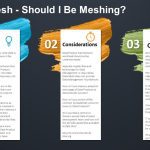Why do you need data quality? Back to my house analogies. Try building a wall or even a house, if the bricks all differ in size and shape, some missing and others are just the wrong type, being large stones instead of bricks. Well, you could probably build it, but would it be fit for purpose and pass the inspection criteria? The same goes for data. If we are going to generate … [Read more...] about 6 ‘P’s For A Data Quality Framework
Big Data
Learn everything you need to know about big data. Find out how companies are using this revolutionary technology and what it means for your business strategy.
Impress With Data Mesh
Data mesh is the nudge that puts us on a new trajectory in how we approach data: how we imagine data, how we capture and share it, and how we create value from it, at scale and in the field of analytics and AI Zhamak Dehghani There is a lot of excitement (and information) around Data Mesh at present; What is it? How can I benefit? How do I get data meshed and should I? Well, … [Read more...] about Impress With Data Mesh
5 Big Benefits of Data and Analytics for Positive Business Outcomes
Following the continued growth of the business industry, approximately 97.2% of organizations have greatly invested in big data to analyze their performance and identify the next step in business. Currently, businesses are capable of collecting data at every point of the customer journey.? The data collected comes from different sources such as digital clicks, interactions, and … [Read more...] about 5 Big Benefits of Data and Analytics for Positive Business Outcomes
How to Stop Ignoring Data Cleansing & Take Control of Your Data Quality
Fun fact data cleansing is often ignored. Executives and decision-makers arent aware of data quality problems while mid-level managers and juniors find it irksome to tackle. Research by the Alation State of Data Culture Report, states: Two-thirds of C-level executives at least sometimes ignore data and make decisions based on intuition. No one wants to deal with the tiring task … [Read more...] about How to Stop Ignoring Data Cleansing & Take Control of Your Data Quality
How Does Spotify’s Algorithm Work
Spotify is one of the most popular music streaming services in the world, along with Apple Music. One of the major reasons for this is data, or specifically the algorithm that the platform uses. This algorithm is constantly working on giving users the best experience possible. It can learn someone's preferences, give them similar recommendations, suggest new genres, or even … [Read more...] about How Does Spotify’s Algorithm Work
What is big data?
Big data is a term that refers to the massive amount of digital data created and shared every day. Big data can transform how we live, work, and communicate. It can be used to improve everything from public health and urban planning to business and marketing.
Big data is also changing the way we think about privacy and security. The volume, velocity, and variety of big data present challenges and opportunities for organizations and individuals. Regardless, big data is here to stay, and its impact will only continue to grow in the years to come.
What is big data analytics?
Big data analytics is the process of turning large, complex data sets into actionable insights. Businesses use various analytical tools and techniques, including machine learning and statistical analysis, to do this.
Big data analytics can be used to improve decision-making in areas like marketing, operations, and customer service. It can also be used to identify new business opportunities and optimize existing processes. With the help of big data analysis, businesses can gain a competitive edge by using their data better.
Want to learn more about big data? Datafloq has courses available. Contact us to get started.
When was big data introduced?
The term big data was coined in the 1990s, with some giving credit to John Mashey for popularizing the term. However, the concept of big data has been around for much longer.
Where does big data come from?
In the early days of computing, scientists and businesses began to realize that the amount of data being generated was increasing exponentially. As a result, they began to develop new methods for storing and processing data.
Over time, these methods have become increasingly sophisticated and have played a key role in enabling businesses to make sense of vast amounts of information. Today, big data is used in various industries, from retail to healthcare, and its importance is only likely to grow in the years to come.
What are examples of big data?
One of the most common examples of big data is social media data. With over 2 billion active users, Facebook generates a huge amount of data every day. This includes information on user interactions, posts, and even location data. Analyzing this data can help companies better understand their customers and target their marketing efforts.
Another example of big data is GPS signals. These signals are constantly being generated by devices like cell phones and fitness trackers. When combined with other data sets, GPS signals can be used to provide insights into everything from traffic patterns to human behavior. Finally, weather patterns are another type of big data set. By tracking these patterns over time, scientists can better understand the impact of climate change and develop strategies for mitigating its effects.
How do companies use big data?
Companies use big data in marketing, product development, and customer service. By analyzing large data sets, businesses can identify patterns and trends that would be otherwise difficult to spot. For example, a company might use big data to track customer behavior patterns to improve its marketing efforts.
Alternatively, a company might use big data to improve its products by identifying areas where customers are most likely to experience problems. For instance, big data can be used to improve customer service by finding pain points in the customer journey. Ultimately, big data provides companies with a valuable tool for gaining insights into their business operations.







